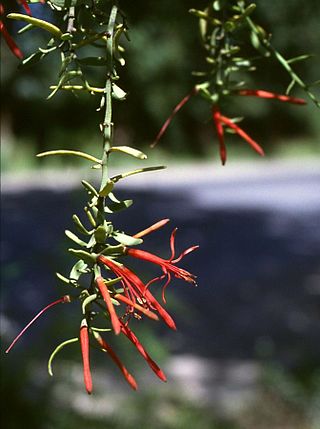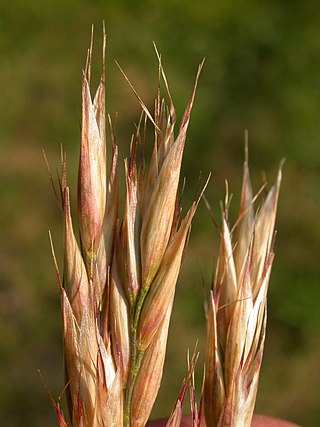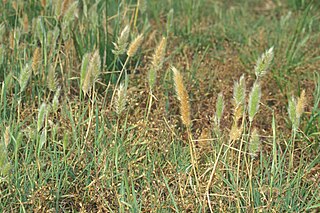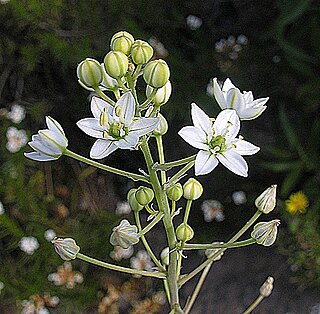
The Santalales are an order of flowering plants with a cosmopolitan distribution, but heavily concentrated in tropical and subtropical regions. It derives its name from its type genus Santalum (sandalwood). Mistletoe is the common name for a number of parasitic plants within the order.

Loranthaceae, commonly known as the showy mistletoes, is a family of flowering plants. It consists of about 75 genera and 1,000 species of woody plants, many of them hemiparasites. The three terrestrial species are Nuytsia floribunda, Atkinsonia ligustrina, and Gaiadendron punctatum Loranthaceae are primarily xylem parasites, but their haustoria may sometimes tap the phloem, while Tristerix aphyllus is almost holoparasitic. For a more complete description of the Australian Loranthaceae, see Flora of Australia online., for the Malesian Loranthaceae see Flora of Malesia.

Ceratophyllum is a cosmopolitan genus of flowering plants including four accepted living species in 2016, commonly found in ponds, marshes, and quiet streams in tropical and in temperate regions. It is the only extant genus in the family Ceratophyllaceae, itself the only extant family in the order Ceratophyllales. They are usually called coontails or hornworts, although hornwort is also used for unrelated plants of the division Anthocerotophyta.

Alstroemeriaceae is a family of flowering plants, with 254 known species in four genera, almost entirely native to the Americas, from Central America to southern South America. One species of Luzuriaga occurs in New Zealand, and the genus Drymophila is endemic to south-eastern Australia.

Schinus is a genus of flowering trees and tall shrubs in the sumac family, Anacardiaceae. Members of the genus are commonly known as pepper trees. The Peruvian pepper tree is the source of the spice known as pink peppercorn.

Grindelia (gumweed) is a genus of plants native to the Americas belonging to the family Asteraceae. The genus was named for Latvian botanist David Hieronymus Grindel, 1776–1836.

Ruppia, also known as the widgeonweeds, ditch grasses or widgeon grass, is the only extant genus in the family Ruppiaceae, with eight known species. These are aquatic plants widespread over much of the world. The genus name honours Heinrich Bernhard Rupp, a German botanist (1688-1719). They are widespread outside of frigid zones and the tropics.

Blandfordia, commonly known as Christmas bells, is a genus of four species of flowering plants native to eastern Australia. Christmas bells are tufted, perennial herbs with narrow, linear leaves and up to twenty large, drooping, cylindrical or bell-shaped flowers.

Olacaceae is a family of flowering plants in the order Santalales. They are woody plants, native throughout the tropical regions of the world. As of July 2021, the circumscription of the family varies; some sources maintain a broad family, others split it into seven segregate families.

Schoepfiaceae is a family of flowering plants recognized in the APG III system of 2009. The family was previously only recognized by few taxonomists; the plants in question usually being assigned to family Olacaceae and Santalaceae.

Danthonia is a genus of Eurasian, North African, and American plants in the grass family. Members of this genus are sometimes referred to as oatgrass, but that common name is not restricted to this genus. Other common names include heathgrass and wallaby grass. Australian species have since been reclassified into the genus Rytidosperma.

Polypogon is a nearly cosmopolitan genus of plants in the grass family, commonly known beard grass or rabbitsfoot grass.

Eclipta is a genus of flowering plants in the family Asteraceae.

Oziroe is a genus of bulbous South American plants in the squill subfamily within the asparagus family. Within the Scilloideae, it is the sole member of the tribe Oziroëeae and the only genus in the subfamily to be found in the New World.
Genlisea tuberosa is a carnivorous species in the genus Genlisea that is endemic to Brazil and found only in campos rupestres vegetation. Lacking any roots, it has unpigmented bundles of "rootlike" subterranean organs, technically leaves, which attract, trap, and digest protozoans. This species is unique in the genus in its formation of tubers. As of 2014, Genlisea tuberosa has the smallest known genome of any flowering plant, at 61 Mbp, or 61,000,000 base pairs.

Arjona patagonica is a species of flowering plant in the family Schoepfiaceae native to southern South America.

Quinchamalium is a genus of flowering plant in the family Schoepfiaceae, with a single species Quinchamalium chilense, native to Chile, Argentina, Peru and Bolivia. Depending on the latitude, it can be found from sea level to 3,800 m in altitude.

Boopis is a genus of flowering plants in the family Calyceraceae, native to Chile, Argentina and Brazil. The taxon is believed to be highly polyphyletic.
Arjona megapotamica is a rare species of flowering plant in the family Schoepfiaceae, native to a small area of southeastern Brazil, where it grows in cool mountain grasslands. Like other Arjona species, it is thought to be a root hemiparasite. It is a small perennial plant growing as a bunch of short twigs from a woody central knob. As of December 2021, Arjona schumanniana was regarded by some sources as a synonym, by others as an independent species.

Alstroemerieae is the name of a tribe of monocotyledonous, herbaceous, perennial plants belonging to the Alstroemeriaceae family. They are native to Central and South America. They have very vivid flowers, relatively large and of various colors. Because of the beauty of their flowers, they are often used as ornamental plants and, especially, as cut flowers.

















